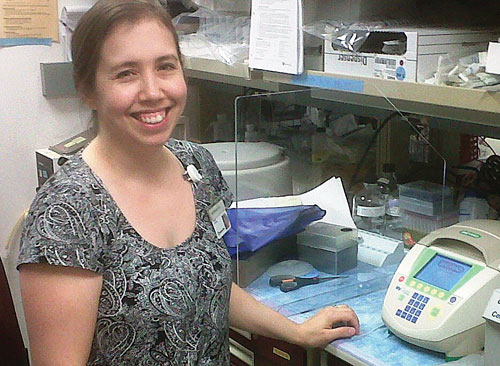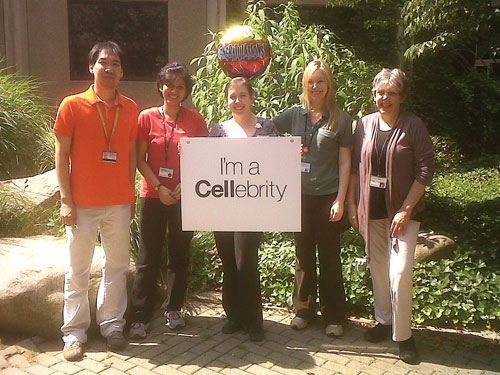July 1, 2010 (Vol. 30, No. 13)
Cleveland Couple Uses Pattern-Recognition and Problem-Solving Skills to Crack Latest Cryptogram
In coming up with “A window on new expression,” a couple based in Cleveland, Ohio, provided the answer that solved GEN’s Cryptogram Challenge: Electroporation.
Jodi Bubenik, Ph.D., a molecular biologist, and her husband, Peter Bubenik, Ph.D., a mathematics professor, said it took them three hours to figure out the puzzle after studying all nine clues. Jodi works at the Lerner Research Institute, which is affiliated with the Cleveland Clinic. Peter teaches at Cleveland State University. The couple, both Canadians, previously were graduate students at the University of Toronto.
GEN, its partner Scintellix and sponsor Bio-Rad Laboratories send a hearty congratulations to the husband-and-wife team. The Bubeniks receive two awards for solving the cryptogram. They win a $1,500 cash prize, and Jodi chose Bio-Rad’s 96-well MyCycler personal thermal cycler for research in the Driscoll Lab at Lerner Research Institute.

Jodi Bubenik, Ph.D.
Peter Johnson, M.D., president and CEO of Scintellix, and vp of R&D at Avery Dennison Medical, is the creator of all the cryptograms in the GEN Challenge series. The Cryptogram Challenge: Electroporation was composed of two images. Image A depicts an artist’s conception of a cell membrane after electroporation. Image B is an artist’s conception of a sheet of cells, four to a grid square, variably expressing green fluorescent protein after transfection with an inhibitor of the gene. Image B also depicts only one of several gene regulation outcomes, since electroporation protocols can be personalized for their degrees of effectiveness based on cell type, buffer constituents, and electroporation settings.
The task was to decode the cipher in Image B.
“The contest represented the power of electroporation to influence cellular behavior,” said Dr. Johnson. “The solution revealed a brief message that illuminates a view toward gene control.”
The Cryptogram Challenge: Electroporation followed five previous contests—the MicroArray Challenge and four Cryptogram Challenges (ELISA, ELISA Redux, RNAi, and RNAi-2)—that each enjoyed great success when presented on GEN’s website beginning in 2008.

Peter Bubenik, Ph.D.
Important Skills
When asked which skills might have helped them solve the Cryptogram Challenge, Jodi told GEN that she has long been addicted to crossword puzzles. “I’ve always been interested in contests and puzzles that involve pattern recognition,” she said.
“Mathematics is about problem-solving and trying to find hidden patterns behind information,” added Peter. “This [the Cryptogram Challenge] is the kind of thing that I like to do.”
In recounting how they went about tackling the cryptogram, Jodi said Clue 1, which referred to the Bio-Rad website, and Clue 2 (“Cell transparencies were important”) got the ball rolling. They next printed out copies of 8 by 12 grids to be able “to scribble around.”
They then focused on Clue 8, which led to a website that displayed a map of Paris. “When you look at that page, it seemed most reasonable that it was the map itself that was the information. It showed the suburbs and neighborhoods of Paris mapped out in numerical order, which forms a spiral from the center out. So we took that to mean that this puzzle was also going to be spiraling out from the center,” explained Jodi.
Using that insight, Jodi and Peter went back to the cryptogram grid. “In the center, there were four squares that could equally be claimed to be the middle of the puzzle. Then we looked at the cell transparencies.
“While adding them up by hand, a pattern emerged that three of the four cells would total 96,” noted Jodi. “That happened over and over in a heavy concentration in the center of the puzzle. But it never occurred in the cells around the edge.”
The Bubeniks then decided that number 96 was important as it suggested where the actual letters of the puzzle might be found. “In hindsight, we were able to use Image A to tell us that,” continued Jodi.
They then referred to the contest rules: five words are in the answer and there is only one space between words, starting at the end and spiraling toward the middle. They next figured out how long each of the words was and the location of the starting point.
“There was one word that was 10 letters long,” said Jodi. Since 10 letters isn’t that common, we were able to use Clue 1 to go back to the Bio-Rad web page and scan for 10-letter words. The word “expression” jumped right out at us. So we plugged that in and tried to see if it would work.
“Then, since there are some duplicate letters in the word ‘expression’ we tried to determine if those cells matched. That’s when Peter was able to see that the same three or four cells that were important to determine the number 96 were also the pattern for the rest of the letters. That allowed us to just write them out and solve the rest of the phrase.”
“Drs. Bubenik solved the most Challenging Cryptogram yet presented,” according to Dr. Johnson. “I toast their acumen and hope that they are ready to take on the cell-counting cryptogram that comes next.”
Stay tuned for our next Cryptogram Challenge: Cell Counting, which will launch on July 12.

Jodi Bubenik (center) and her husband solved the most challenging cryptogram yet presented. Jodi was subsequently lauded as a “Cellebrity” by Bio-Rad, sponsor of the contest.



